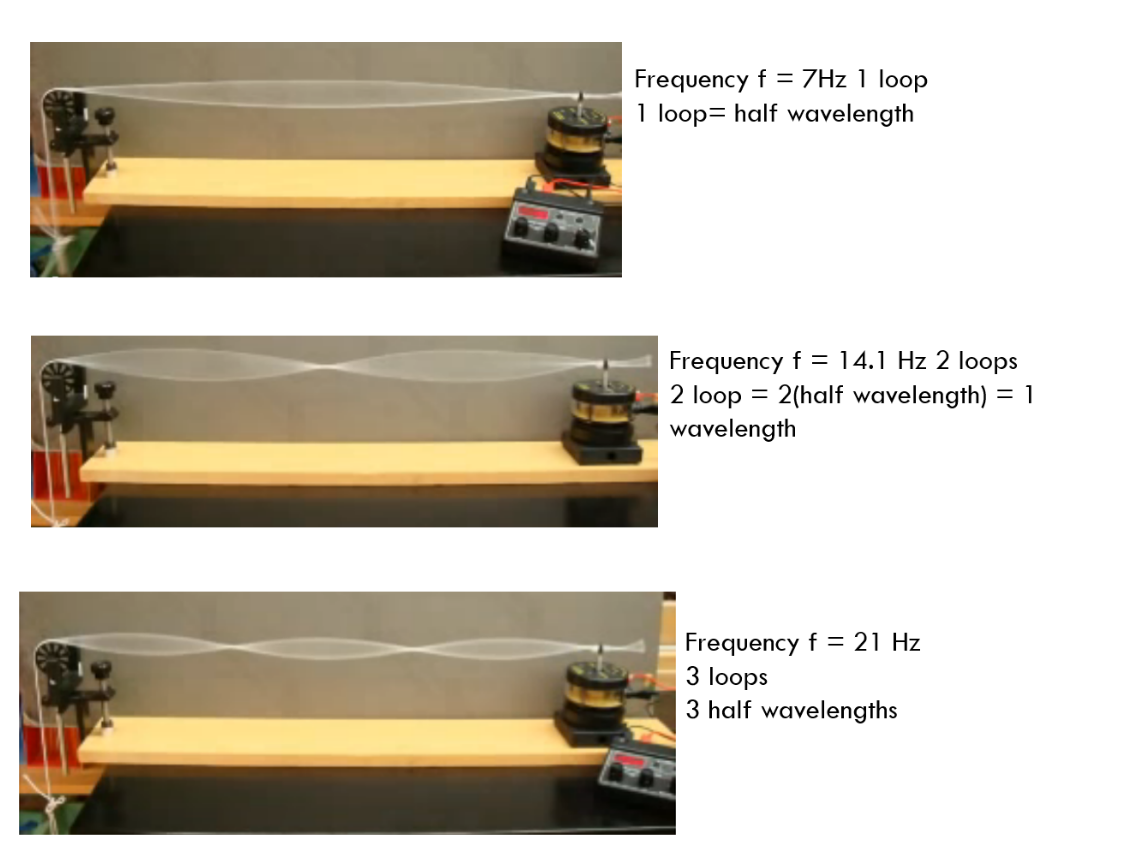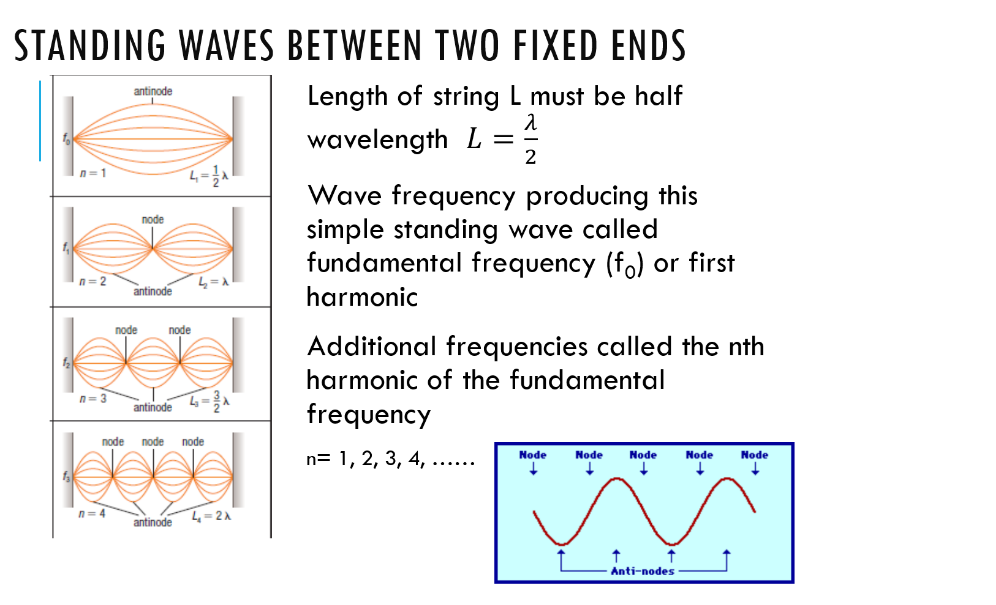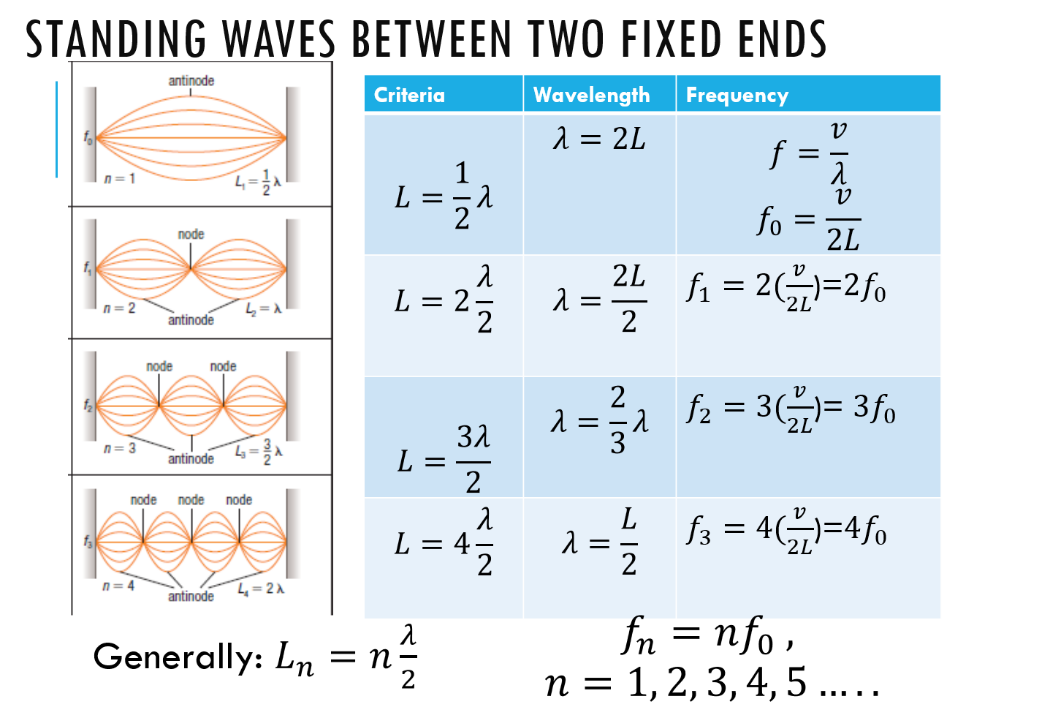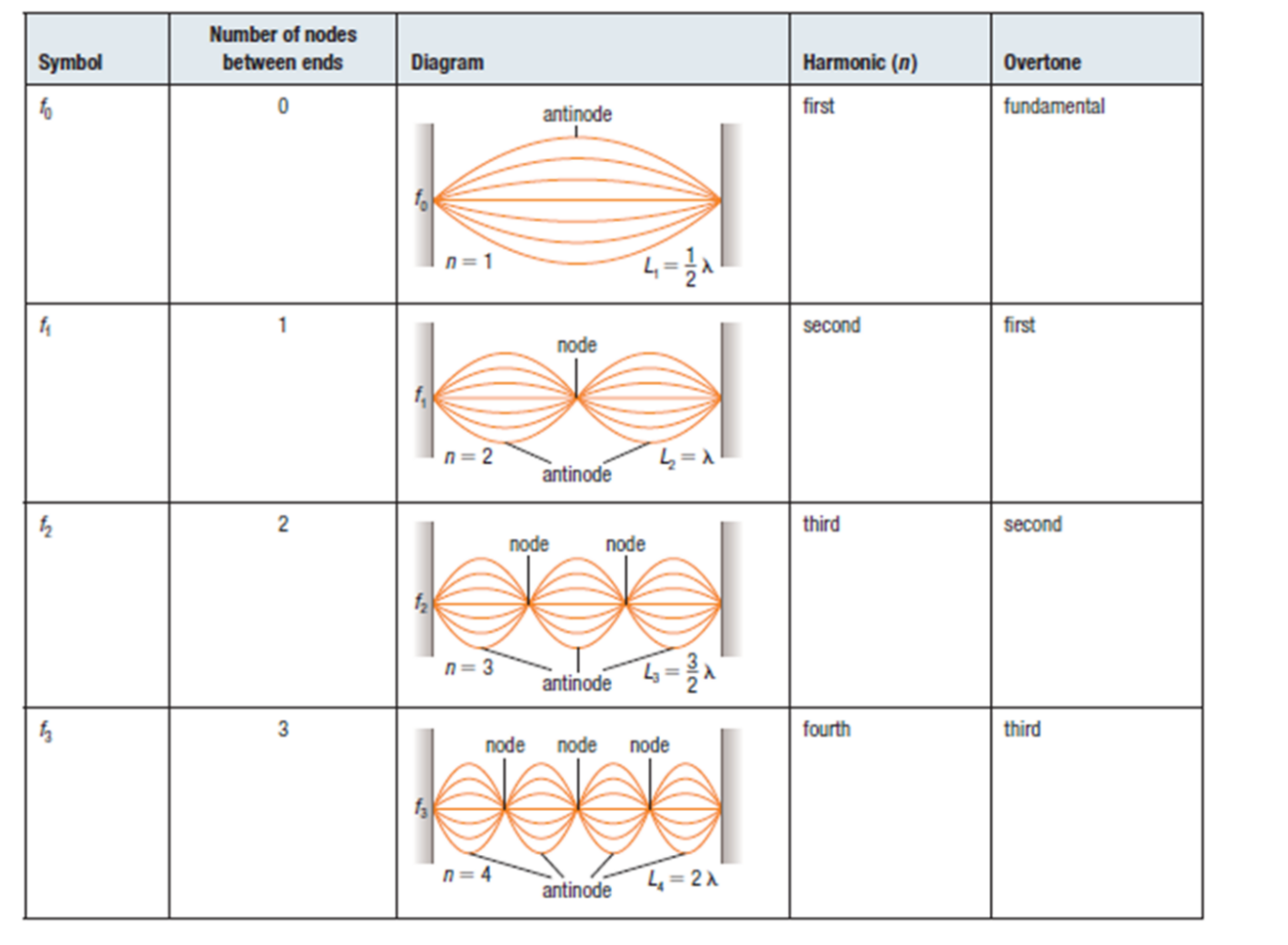Waves
Wave Properties
Vibration
- Vibration: the cyclical motion of an object about an equilibrium point
- A vibration can also be called an oscillation
Cycle
- Cycle: when the object returns to where it started from it has completed one cycle
Torsional Vibration
- Torsional Vibrations: the rotational motion of an object spinning about an equilibrium point
Simple Harmonic Vibration
- Simple harmonic motion (SHM) is any motion that repeats itself at regular intervals with the same amplitude.
Parts of a Wave
Medium: the material the wave travels through
Crest: Highest point on a wave
Trough: Lowest point on a wave
Amplitude (A): The maximum displacement from rest
Wavelength (λ = lambda): distance between two adjacent crests (or troughs)
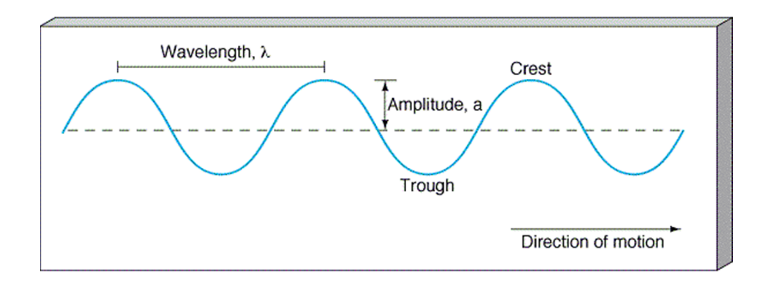
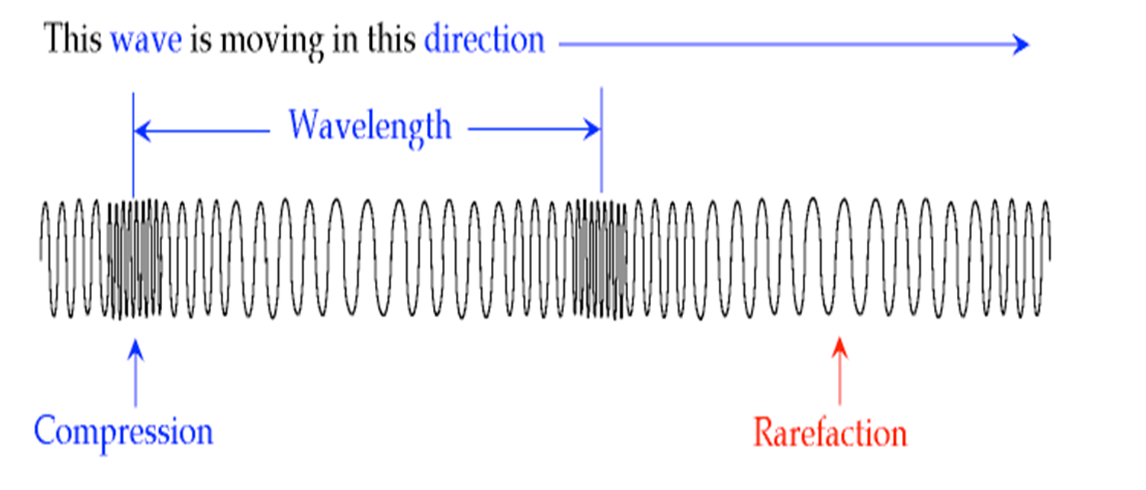
Period (T): The time it takes for a particle to complete one cycle
- measured in seconds (s)
Frequency (f): the number of cycles completed in one second
- measured in Hertz (H)

Universal Wave Equation
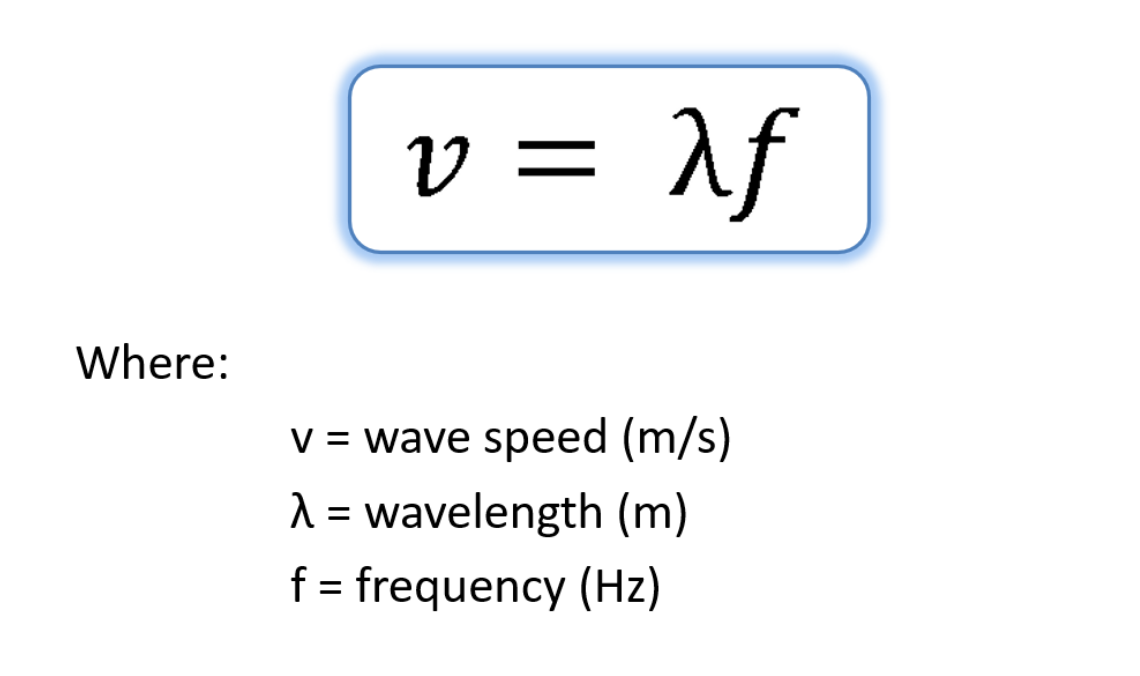
Mechanical Waves
Transverse Wave
- %%The medium's particle motion is perpendicular to the wave's direction.%%
- Examples
- light
- guitar strings
Longitudinal Waves
%%The medium's particles move parallel to the wave's direction.%%
Example
- sound
Longitudinal waves: waves that cause the medium's particles to oscillate back and forth (parallel to the direction in which the wave is travelling)
Compression (C): a space created by the vibration of longitudinal waves where the particles or molecules are closer to one another than usual
Rarefaction (R): an area in a longitudinal wave where the molecules or particles are further apart than usual

Phases of Vibration
- Vibrations can either be in-phase or out of phase
- In-phase: vibrations pass through the rest position at the same time and during the same period
- Out of phase: vibrations pass through in the same or a different period, but pass through the rest position at different points in time
Phase Shift
an entire wave that is moved along the x-axis in comparison to another wave that is otherwise the same
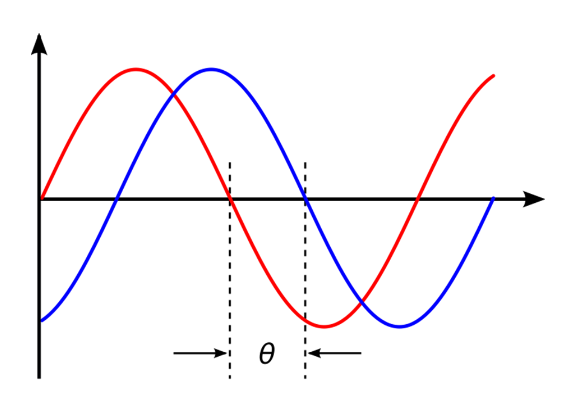
Speed of Waves in a Medium
Molecular Forces
- Using waves to transfer energy is more effective if the particle vibrations don't absorb a lot of energy.
- When fully inflated, a more rigid object, like a soccer ball, tends to bounce more effectively.
- Strong intermolecular forces between the object's atoms allow for more efficient wave energy transmission and faster wave speed.
- Wave speeds slow down and energy transmission becomes less effective when these forces are weaker.
Temperature and Gases
- Cooler gases have a higher density, which makes them better at transmitting sound.
- Warmer molecules, on the other hand, move more quickly and transfer kinetic energy more effectively.
Linear Density
The characteristics of a string, like those of a violin or guitar string, determine the transverse wave's speed.
The amount of force that is required to cause a string to vibrate depends on its linear density or mass per unit distance.
Linear density, µ, is calculated using the equation:
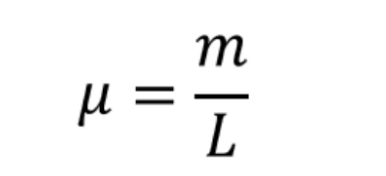
m is the mass
L is the length
µ is the linear density
Speed & Tension
The transmission of wave energy is influenced by the tension in a string.
The energy is quickly absorbed by a loose string. However, a taut (tight) string will transfer energy very efficiently.
Only linear density and tension have any effect on how fast waves can move along a string. The formula for a wave's speed along a string is:


Sound Waves
- When an object vibrates quickly, it releases energy as a longitudinal wave (a series of high and low-pressure regions).
- Because this energy activates the auditory nerve in the human ear, we can hear "sounds."
Range of Hearing
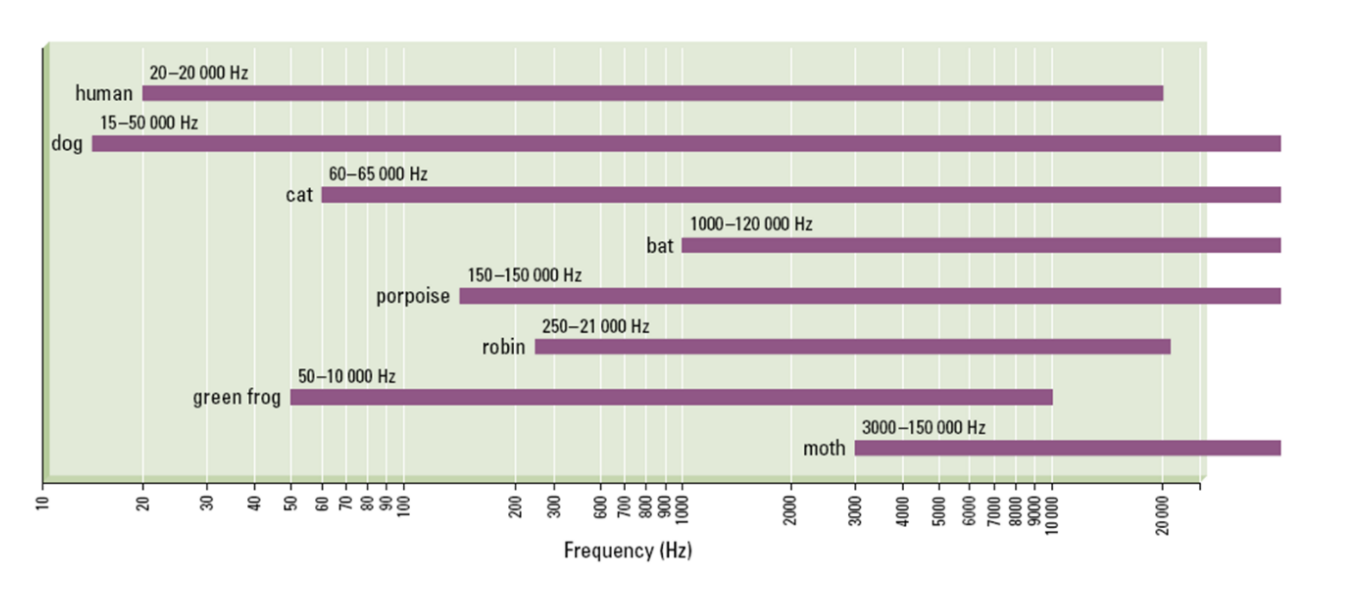
Sound Range
- Infrasonic wave: sound waves with a frequency below 20 Hz.
- Ultrasonic wave: sound wave with a frequency above 20 kHz.
- Audible sound wave: sound wave in the range of human hearing, 20 Hz to 20 kHz.
Wave Medium
- Sound waves need a medium to propagate.
Speed of Sound
The speed of sound is slower than the speed of light
- Example: you see lightning before you hear thunder
- This is because the speed of light is faster, so you see lightning first. Since the speed of sound is much slower, you hear the sound of thunder after.
Sound travels fastest in solids and slowest in gases
- speed of sound in solid > liquid > gas
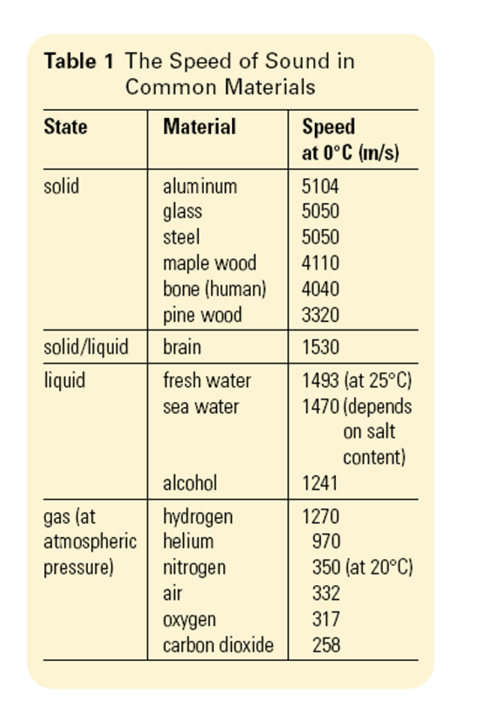
Speed of Sound in Air
The speed of sound in the air is dependent on the air temperature

Speed of Sound and Mach Number
- sonic speeds:
- speeds at the speed of sound
- supersonic speeds:
- speeds above the speed of sound
- sonic boom:
- a shockwave is formed when an object reaches or exceeds the speed of sound
- A sonic boom occurs as an object meets or goes through the barrier of waves infront of the sonic or supersonic moving object
Mach Number
The speed of sound is relative to the Mach number
- Mach 1 is 1x the speed of sound
- Mach 2 is 2x the speed of sound
- Mach 3 is 3x the speed of sound
- etc

Sound Intensity
- The amount of sound energy being transmitted per unit area per second is called the sound intensity (W/m^2)
- An indirect indicator of a wave's energy transfer is the wave's amplitude.
- You can hear a sound louder if the sound wave's amplitude is larger.
- The threshold of the human hearing range is about 1 x 10-12 W/m^2.
**SOUND REFLECTION \n **& DOPPLER AFFECT
Sound Reflection & Doppler Effect
Reflection of Sound
- Echoes are the sound's reflection off of a solid surface. They can only be distinguished if there are more than 0.1 seconds between the original sound and the reflection.
Echo-Sounding
- A tool used to gauge the depth of the ocean is an echo-sounder.
- A similar tool is used by the fishing industry to locate fish schools.
- These devices are known as SONAR (sound navigation and ranging)
Echolocation
- Echolocation is the analysis of reflected sound to determine the location of objects.
- Dolphins, orca whales and bats produce clicks, whistles and other sounds and use the reflection to navigate.
Doppler Effect
If an observer and a sound source are moving relative to one another, this effect involves a change in wavelength and frequency.
Compared to if the source were at rest, the waves behind a moving source have a lower frequency and a longer wavelength.
In comparison to waves coming from a stationary source, those coming from a moving source have a greater frequency and a shorter wavelength.
Examples:
- Radar guns
- Wind speeds using weather station devices.
- Red Shift
The summary of this effect is:
- The speed of the wave is constant.
- If the wavelength increases then the frequency decreases.
- If the wavelength decreases then the frequency increases.
Calculating the Doppler Effect
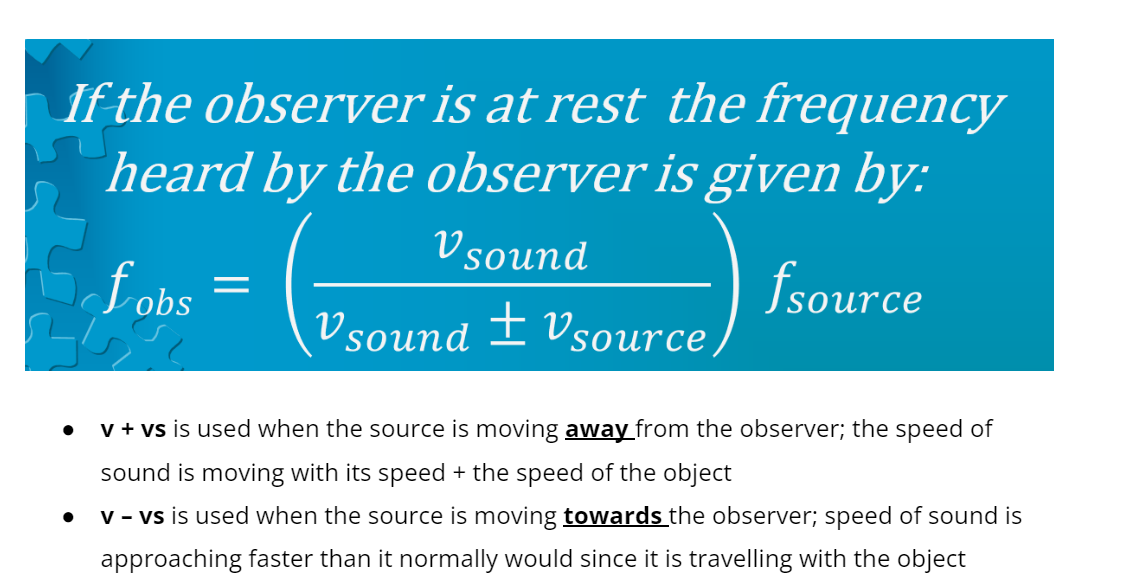
Interference of Waves
Interaction occurs when two waves superimpose themselves after crossing paths.
Interference is the term used to describe how waves interact in the same medium.
When two or more waves combine, the process of creating a new wave occurs.
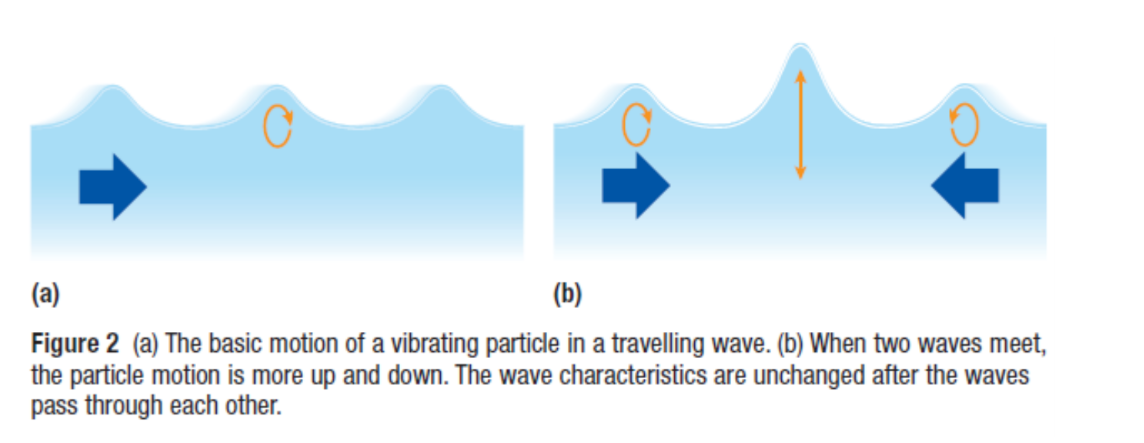
Principle of Superposition
- The two interfering waves' combined amplitudes are equal to their individual amplitudes at any point.
- Results Amplitude = Results A + Results B
- ==NOTES==
- A trough is negative, and a crest is positive.
- When two waves cross paths, neither their size nor shape changes. They are able to cross each other. However, a temporary wave with a different shape emerges when they collide!
Constructive Interference
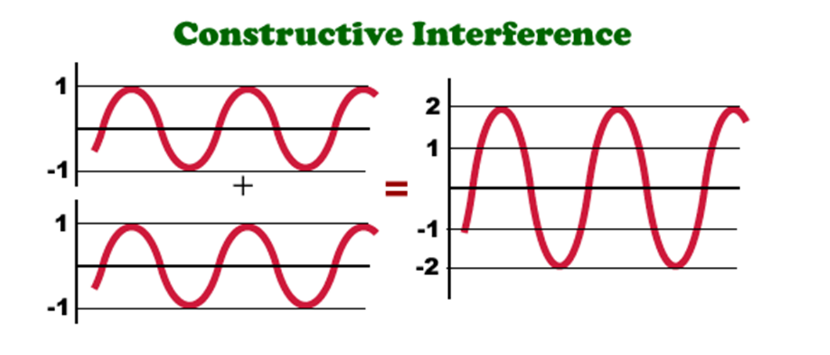
- waves are in phase
- crest combines with crest & troughs combine with troughs
- The resultant wave has an amplitude that is greater than the amplitude of either individual wave (super crests and troughs)
Destructive Interference
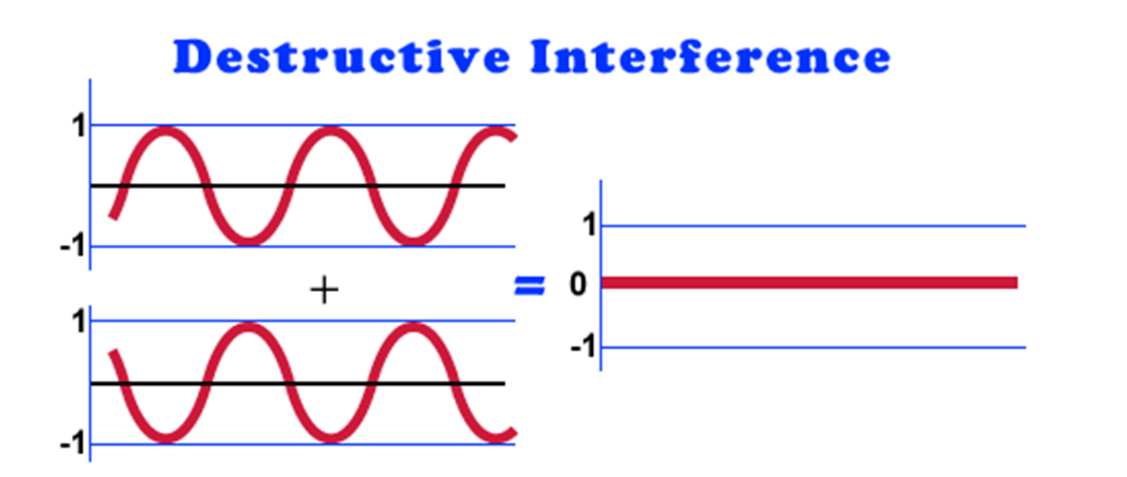
- Waves out of phase
- crest of one wave coincide with the trough of the other wave.
- The resultant wave has an amplitude that is smaller than either of the individual waves.
Beats
It is known as "beating" or "producing beats" when two sound waves of different frequencies come close to your ear and undergo alternately constructive and destructive interference, which causes the sound to alternately be soft and loud.
The frequency of the wave produced by the interference of two waves with slightly different frequencies is known as the beat frequency.
The absolute value of the difference in frequency between the two waves determines the beat frequency.

Use of Beats
- By comparing the musical note with a reference note, such as a guitar string, beats can be used to tune musical instruments.
- The guitar string is simultaneously sounded, and a tuning fork tuned to the desired frequency is used.
- The guitar string is tuned until a beat frequency can no longer be heard.
Waves at a Media Boundary
Media Boundary
- The medium is the substance through which the wave is spreading.
- Boundary: The point at which two media meet.
- Examples include water-air, glass, and wood. a drum head's edge
- The wave splits into two at a media boundary that is not strictly a free-end or fixed-end boundary.
- The transmission of one wave and the reflection of the other.
- The transmitted wave and the reflected wave might not share the same amount of the original wave's amplitude.
- The two amplitudes must add up to the same amount as the original wave's amplitude.
Types of Boundary Reflection-Free End
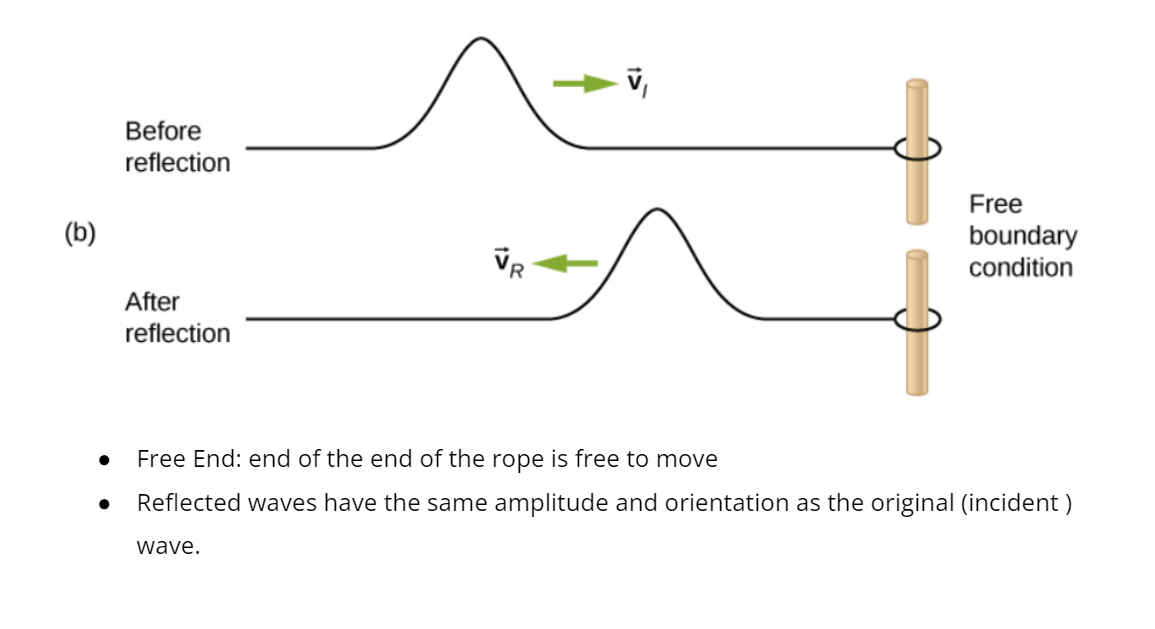
Types of Boundary Reflection- Fixed End
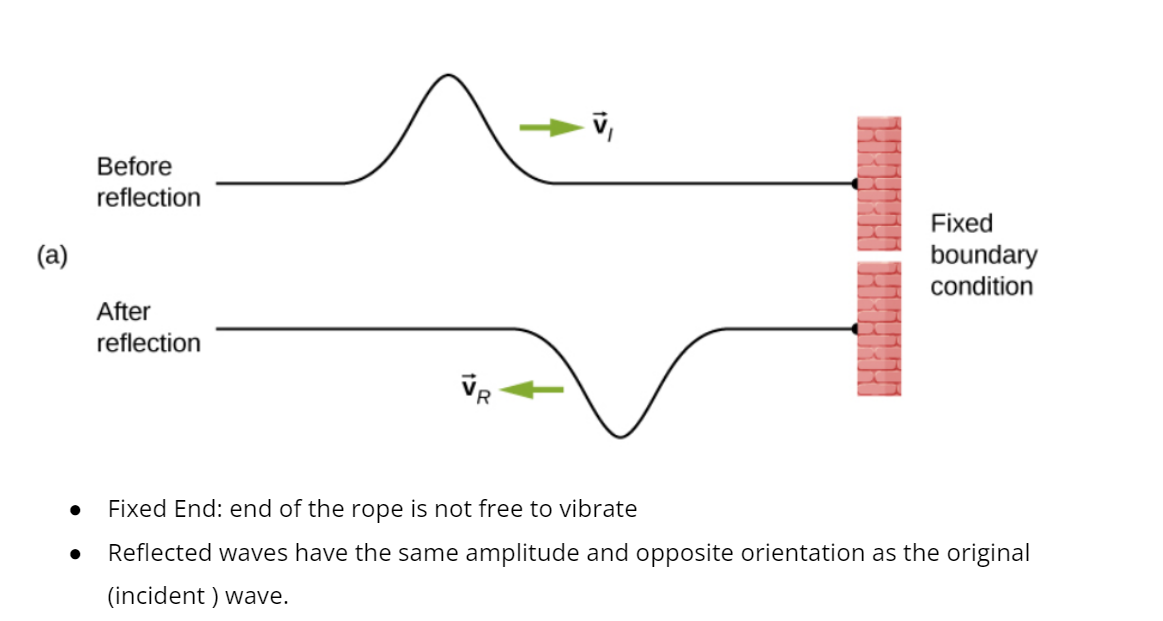
Real Boundaries
- Water to air
- Air to tree
- Real boundaries are not free-end or fixed end
- The original waves will split into two waves
- Part of the wave energy is reflected, and part is transmitted
Wave Moving from Faster to Slower Medium
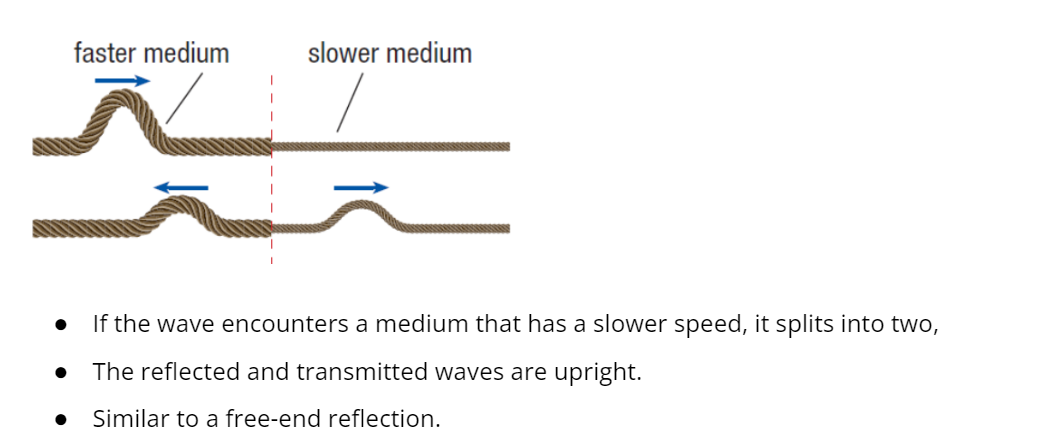
Wave Moving from Slower to Faster Medium
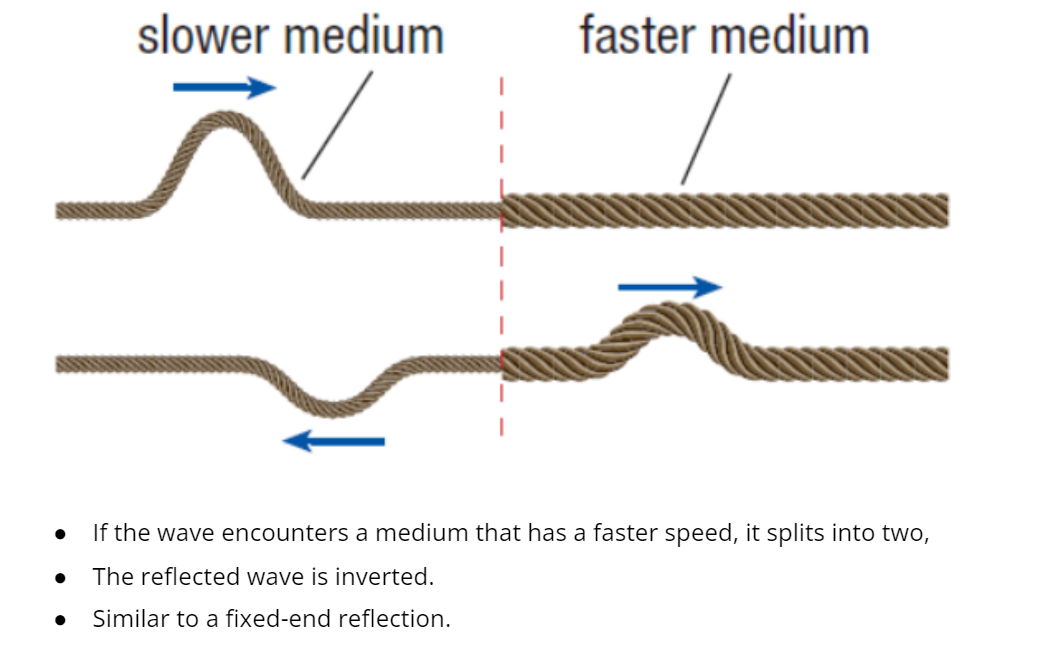
Standing Wave
When incoming and reflected waves collide, an interference pattern is created.
Identical-sized waves that are moving in the opposite direction.
Node: a point in the medium where particles are at rest.
Antinode: the region in a medium where particles move most quickly
Amplitude 2 times that of original wave
